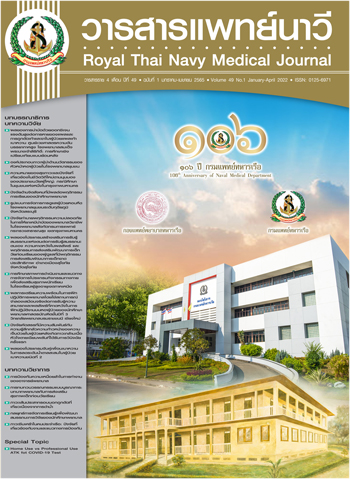The Components of Innovative Leadership of Head Nurses in Community Hospitals
Main Article Content
Abstract
The mixed method research aimed to study the components of innovative leadership of head nurses in community hospitals. The sample was 10 persons selected by snowball sampling technique for qualitative study, and it included 423 nurses selected by stratified random sampling. The collected data was 2 stages (First stage, qualitative research data was collected by in-depth interviews and second stage, quantitative research data was collected by questionnaire with rating scale 5 point scale). The quality of the data was checked by using a triangular method and the content validity was determined with the content validity index = 0.96 and the coefficient of Cronbach’s alpha = 0.98. The qualitative data was analyzed by content analysis (Colaizzi’s method) and the quantitative data was analyzed by using descriptive statistic and analyzed the components statistic by using Exploratory Factor Analysis and Confirm Factor Analysis.
The research findings were the components of innovative leadership with qualitative research had 8 components but the result of Exploratory Factor Analysis (EFA) was 5 components (52 variables) (Eigen value ≥ 1, % of valance cumulative 72.042, the factor loading ≥ .3) and the Confirm Factor Analysis by the test of the congruence of the empirical data with the conceptual framework showed the following results: (Chi-square c2 = 24.939 df = 319 P-value=1.000 c2/df (CMIN/DF) = 0.078 GFI = .994 AGFI = .993 NFI = .997 CFI = 1.000 RMSEA = .000) with 5 components (27 variables); 1) Innovation vision and strategy (14 variables), 2) decision making for innovation (3 variables), 3) innovation and research utilization (3 variables), 4) innovation team management (3 variables), and 5) managing performance through reward system (4 variables). This research points out that the new explicit knowledge of the components of innovative leadership of head nurses which is consistent with the community hospitals context is a quality tool that can be applied to assess or develop innovative leadership in the community hospital contexts of Thailand.
Article Details

This work is licensed under a Creative Commons Attribution-NonCommercial-NoDerivatives 4.0 International License.
References
Joseph LM. Organizational culture and climate for promoting innovativeness. The Journal of Nursing Administration 2015;45(3):172-8.
Singchungchai P. Innovative leadership in nursing management. The Southern College Network Journal of Nursing and Public Health 2019;6(1):260-6. (in Thai).
Bureau of Information Office of Permanent Secretary, Ministry of Public Health. National strategy 20 years in 2016. [Internet]. [cited 2018 November 20 ]. Available from: https://waa.inter.nstda.or.th. (in Thai).
Marquis BL, Huston CJ. Leadership roles and management functions in nursing: theory and application. 9th ed. Philadelphia: Lippincott; 2017.
Adair J. Leadership for innovation: how to organize team creativity and harvest Ideas. London: Kogan Page; 2009. p. 21-3.
Gliddon DG, Rothwell WJ. Innovation leadership. New York: Routledge Publishers; 2018.
Buachu T, Wivatvanit S. Innovation leadership of head nurse, Government University Hospital. JNSCU 2017;29(1):141-53. (in Thai).
Panthong P, Ratchukul S. Innovative leader characteristics of head nurses in general hospital. JNSCU 2016;28(2):15-24. (in Thai).
Creswell JW. Qualitative inquiry and research design: choosing among tradition. California: SAGE Publications; 1998.
Kaihin R. The pilot study for the components of innovative leadership of head nurse in community hospitals, part 1: qualitative research report. Nakhon Pathom: Christian University of Thailand; 2019. (in Thai).
Kaihin R, Singchungchai P, Pathumarak N. Innovative leadership experience of head nurses in community hospitals. The Southern College Network Journal of Nursing and Public Health 2021;8(3):138-49. (in Thai).
Singchungchai P. Principle and using qualitative research in nursing and health. 3th ed. Songkhla: Chanmuang Press; 2009. p. 85. (in Thai).
Ministry of Public Health. The structure of hospital in 2018. [Internet]. [cited 2019 April 2]. Available from: http://www.pngo.moph.go.th/pngo/phocadownload/adminis/struck.pdf.
Krejcie RV, Morgan DW. Determining sample size for research activities. Educational and Psychological Measurement 1970;30(3):607-10.
Polit DF, Hungler BP. Nursing research principles and methods. 6th ed. Philadelphia: Lippincot; 1999.
DeVellis RF. Scale development: theory and application. 2nd ed. California: SAGE Publications; 2011. p. 22-8.
Denzin NK, Lincoln YS, editors. The SAGE handbook of qualitative research. California: SAGE Publications; 2011. p. 1-9.
Burns N, Grove SK. The practice of nursing research: conduct, critique, & utilization. 4th ed. Philadelphia: W.B. Saunders; 2001.
Schumacker RE, Lomax RG. A beginner’s guide to structural equation modeling. 3rd ed. New Jersey: Lawrence Erlbaum Associates; 2010.
Brown T, Rodger S. Research utilization models: frameworks for implementing evidence-based occupational therapy practice. Occupational Therapy International 1999;6(1):1-23.
Jaiswal NK, Dhar RL. Transformational leadership, innovation climate, creative self-efficacy and employee creativity: a multilevel study. International Journal of Hospitality Management 2015;51:30-41.
Wongtienlai K, Usaho C, Chaemchoy, S. A needs assessment academic management of nursing college under the jurisdiction of ministry of defense base on the concept of innovator competencies of nursing student. Royal Thai Navy Medical Journal 2019; 46(2):506-21. (in Thai).
Bass BM, Avolio BJ. Transformation leadership and organizational culture. PAQ Spring 1993; 17(1):114-22.

